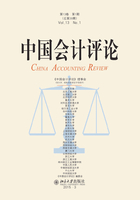
参考文献
[1]陈仕华、马超,2011,企业间高管联结与慈善行为一致性,《管理世界》,第12期,第87—95页。
[2]陈运森、谢德仁,2011,网络位置、独立董事治理与投资效率,《管理世界》,第7期,第113—127页。
[3]陈运森、谢德仁,2012,董事网络、独立董事治理与高管激励,《金融研究》,第2期,第168—182页。
[4]陈运森、谢德仁、黄亮华,2012,董事的网络关系与公司治理研究述评,《南方经济》,第12期,第84—93页。
[5]陈运森,2012,独立董事网络中心度与公司信息披露质量,《审计研究》,第5期,第92—100页。
[6]程小可、孙健、姚立杰,2010,科技开发支出的价值相关性研究——基于中国上市公司的经验证据,《中国软科学》,第6期,第141—150页。
[7]黄亮华、谢德仁,2014, IPO前的业绩压力,现金流约束与开发支出会计政策隐性选择,《南开管理评论》,第6期,第72—82页。
[8]姜博、郑登津、汤晓燕,2014,高管持股变动与开发支出会计政策选择,《投资研究》,第12期,第56—73页。
[9]李维安、邱艾超、牛建波、徐业坤,2010,公司治理研究的新进展:国际趋势与中国模式,《南开管理评论》,第13期,第13—24页。
[10]刘军,2009,《整体网分析讲义》,上海:格致出版社。
[11]卢昌崇、陈仕华,2009,断裂联结重构:连锁董事及其组织功能,《管理世界》,第5期,第52—64页。
[12]毛成林、任兵,2005,公司治理与连锁董事间的网络,《中国软科学》,第12期,第127—132页。
[13]王亮亮、王跃堂、杨志进,2012,会计准则国际趋同、研究开发支出及其经济后果,《财经研究》,第2期,第49—60页。
[14]谢德仁,2004,独立董事是装饰品吗:从报酬委员会和审计委员会来看,《审计研究》,第6期,第26—30页。
[15]谢德仁、陈运森,2012,董事网络:定义、特征和计量,《会计研究》,第3期,第44—51页。
[16]谢德仁、姜博、刘永涛,2014,经理人薪酬辩护与开发支出会计政策隐性选择,《财经研究》,第1期,第123—133页。
[17]谢德仁、刘永涛,2013,开发支出会计政策隐性选择与审计师变更,清华大学工作论文。
[18]许罡、朱卫东,2010,管理当局、研发支出资本化选择与盈余管理动机——基于新无形资产准则研发阶段划分的实证研究,《科学学与科学技术管理》,第9期,第39—43页。
[19]叶建芳、刘大禄,2008,从大族激光公司看研发支出的处理,《财政监督》,第18期,第67—68页。
[20]周兰、宋雁群,2011,高新技术企业R&D资本化的信息有用性研究,《中央财经大学学报》,第9期,第92—96页。
[21]宗文龙、王睿、杨艳俊,2009,企业研发支出资本化的动因研究——来自A股市场的经验证据,《中国会计评论》,第4期,第439—454页。
[22]Aboody, D. and B. Lev, 1998, The value relevance of intangibles: The case of software capalization, Journal of Accounting Research,36,161—191.
[23]Adams, R. B. and D. Ferreira, 2007, A theory of friendly boards, Journal of Finance,62(1),217—250.
[24]Andres, C. and M. Lehmann, 2010, Is busy really busy? Board governance revised, Working Paper.
[25]Battiston, S., E. Bonabeau and G. Weisbuch, 2003, Decision making dynamics in corporate boards, Physica A Statistical Mechanics & Its Applications,322(1—4),567—582.
[26]Bizjak, J., M. Lemmon and R. Whby, 2009, Option backdating and board interlocks, Review of Financial Studies,22,4821—4847.
[27]Brickley, J. A. and J. L. Zimmerman, 2010, Corporate governance myths: Comments on Armstrong, Guay, and Weber, SSRN Electronic Journal,50(2—3),235—245.
[28]Brown, J. L. and K. D. Drake, 2014, Network ties among low-tax firms, The Accounting Review,89(2),483—510.
[29]Bushee, B. J., 1998, The influence of institutional investors on myopic R&D investment behavior, Accounting Review,73(3),305——333.
[30]Cai, Y., D. S. Dhaliwal, Y. T. Kim and C. Pan, 2014, Board interlocks and the diffusion of disclosure policy, Review of Accounting Studies,19(3),1086—1119.
[31]Callimaci, A. and S. Landry, 2004, Market valuation of research and development spending under Canadian GAAP,Canadian Accounting Perspectives,3(1),33—54.
[32]Cao, Y., D. Dhaliwal, Z. Li and Y. G. Yang, 2014, Are all independent directors equally informed evidence based on their trading returns and social networks, Management Science, Forthcoming.
[33]Cazavan-Jeny, A. and T. Jeanjean, 2006, The negative impact of R&D capitalization: A value relevance approach, European Accounting Review,15(1),37—61.
[34]Cazavan-Jeny, A., T. Jeanjean and P. Joos, 2010, Accounting choice and future performance: The case of R&D accounting in France, Journal of Accounting and Public Policy, Article in Press.
[35]Chen, X., Q. Cheng and X. Wang, 2010, Does increased board independence reduce earnings management? Evidence from recent regulatory reforms, Working Paper.
[36]Chiu, P. C., S. H. Teoh and F. Tian ,2013, Board interlocks and earnings management contagion, The Accounting Review,88(3),915—944.
[37]Daley, L. A. and R. L. Vigeland, 1983, The effects of debt covenants and political costs on the choice of accounting methods: The case of accounting for R&D costs, Journal of Accounting and Economics,5,195—211.
[38]Davis, G. F. and H. R. Greve, 1997, Corporate networks and governance changes in the 1980s, The American Journal Sociology,103(1),1—37.
[39]Dechow, P. M. and R. G. Sloan, 1991, Executive incentives and the horizon problem: An empirical investigation, Journal of accounting and Economics,14(1),51—89.
[40]Dinh, T., H. Kang and W. Schultze, 2009,Discretionary Capitalization of R&D:The Trade-off Between Earnings Management and Signaling, Social Science Electronic Publishing.
[41]Duchin, R., O. Ozbas and B. A. Sensoy, 2010, Costly external finance, corporate investment, and the subprime mortgage credit crisis, Journal of Financial Economics,97(3),418—435.
[42]Eisenbeis, R. A. and A. S. Mccall, 1978, The impact of legislation prohibiting director-interlocks among depository financial institutions, Journal of Banking and Finance,2,323—337.
[43]Fama, E. F., 1980, Agency problems and the theory of the firm, Journal of Political Economy,88(2),288—307.
[44]Fama, E. F. and M. C. Jensen, 1983, Separation of ownership and control, J. L. & Econ,26(2),301—325.
[45]Grossman, S. J. and O. D. Hart, 1980, Takeover bids, the free-rider problem, and the theory of the corporation, Bell Journal of Economics,11(1),42—64.
[46]Haunschild, P. R., 1993, Inter organizational imitation: The impact of interlocks on corporate acquisition activity, Administrative Science Quarterly,(38),564—592.
[47]Kang, E. and B. R. Tan, 2008, Accounting choices and director interlocks: A social network approach to the voluntary expensing of stock option grants, Journal of Business Finance and Accounting,35(9),1079—1102.
[48]Krackhardt, D., 1987, QAP Partialing as a test of spuriousness, Social Networks,(9),171—186.
[49]Larcker, D. F., C. S. Eric and W. Charles, 2013, Boardroom centrally and stock returns, Journal of Accounting and Economics,55(2—3),225—250.
[50]Mande, V., U. Nebraska, R. G. File, U. Nebraska, W. Kwak and U. Nebraska, 2000, Income smoothing and discretionary R&D expenditures of Japanese firms, Contemporary Accounting Research,17(2),263—302.
[51]Masulis, R. W. and S. Mobbs, 2011, Are all inside directors the same? Evidence from the external directorship market, Journal of Finance,66(3),823—872.
[52]Mizruchi, M. S., 1996, What do interlocks do? An analysis, critique and assessment of research on interlocking directorates, Annual Review of Sociology,22,271—298.
[53]Nguyen, B. D., 2009, Does the rolodex matter? Corporate's small world and the effectiveness of board of directors, Working Paper.
[54]Palmer, D., P. D. Jenning and X. Zhou, 1993, Late adoption of the multidivisional form by large U. S. corporation: Institutional, political and economic accounts, Administrative Science Quarterly,38,100—131.
[55]Pfeffer, J., 1972, Size and acomposition of corporate boards of directors: The organization and its environment, Administrative Science Quarterly,2,218—228.
[56]Prencipe, A., G. Markarian and L. Pozza, 2008, Earnings management in family firms: Evidence from R&D cost capitalization, Family Business Review,21(1),71—88.
[57]Salancik, G. R. and J. Pfeffer, 1978, Uncertainty, secrecy, and the choice of similar others, Social Psychology,3,246—255.
[58]Shleifer, A. and R. W. Vishny, 1986, Large shareholders and corporate control, Scholarly Articles,94(3),461—488.
[59]Stuart, T. E. and S. Yim, 2010, Board interlocks and the propensity to be targeted in private equity transactions, Journal of Financial Economics,97(1),174—189.
[60]Zahra, S. A. and J. A. Pearce, 1989, Boards of directors and corporate financial performance: A review and integrative model, Journal of Management,15(2),291—334.